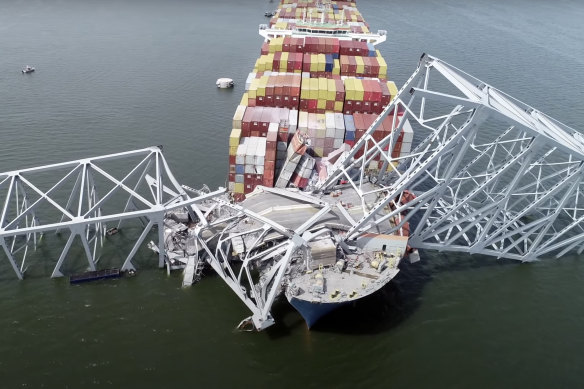[ad_1]
It's been a week since the container ship Daly collided with the Francis Scott Key Bridge in Baltimore. It's still stuck there, and the photos are still stunning, partly because of the ship's enormity compared to what's left of the bridge. How did planners not realize that operating giant ships in the port's narrow waters was dangerous?
With the ship and the bridge blocking the port's entry, the Port of Baltimore remains closed. How big of a deal is this for the economy?

Image taken from a video released by the National Transportation and Safety Board, showing the freighter Daly stuck under part of the structure of the Francis Scott Key Bridge.credit: AP
Well, it would have been very big if it had happened in late 2021 or early 2022, when global supply chains were under significant pressure. Remember when all those ships were sailing back and forth near Los Angeles, waiting to dock?
It matters less now: Before Daly, Baltimore was the 17th busiest port in the United States, and there appears to be enough spare capacity to divert most of the freight that would normally pass through Baltimore to other East Coast ports. Daly was never granted, the ship that blocked the Suez Canal when it ran aground in 2021.
However, global supply chains are no longer in the slump they were, say, last summer, now that pandemic disruptions are mostly a thing of the past, because Baltimore is not the only problem. The Panama Canal is operating at reduced capacity because historic drought, perhaps partly the result of climate change, has limited the water supply to fill the canal's locks.
download
in another place, The Houthis fire missiles When ships entering or leaving the Red Sea, i.e. heading to or from the Suez Canal. Presumably as a result of these and other problems, the New York Fed's widely cited indicator of global supply chain stress, although still not flashing the red lights it was showing in the winter of 2021-2022, has deteriorated significantly. Since last August.
Given what we know about the causes of higher inflation in 2021-2022, this worsening makes me a bit nervous.
I think it's fair to say that the vast majority of economists have been stumped in one way or another by inflation developments over the past three years. Along with many others, it failed to predict the large initial rise in inflation. But even most economists who got this part right seem to have been right for the wrong reasons, because they failed to predict a “total deflation” in 2023: inflation was down, though there was no recession, and unemployment was high as some claimed. It will never be necessary to reduce inflation.
[ad_2]
Source

